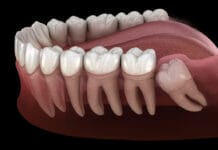Disclosure: This quiz is sponsored content from DenMat as part of our sponsored partner program.
Regular use of Fluoridex toothpaste increases the tooth’s resistance to acid dissolution as well as the penetration of fluoride ions to tooth enamel. The recommended amount of fluoride for children under three years old is 1000 ppm.
Modern diets have been known to increase the potential for tooth decay. The absence of fluoride in toothpaste leads to a thin biofilm on the tooth surface that aids in the growth of bacteria, eventually weakening the enamel. The regular use of Fluoridex toothpaste increases the tooth’s resistance to the negative effects of this bacteria. Studies show the following amounts of fluoride in toothpaste is recommended: 1000 ppm for children under the age of 3 and 1350-1500 ppm for children between ages 3 and 6.
Ziarati, Parisa & Umachandran, Krishnan & Sawicka, Barbara & Adom, Dickson & A. El-Esawi, Mohamed. (2018). Fluoridex Daily Defense Toothpaste for Oral and Dental Health: A Review. 3. 1-10. 10.24262/jmd.3.3.18034.
The development of toothpaste first dates back to 300-500 BC in China and India.
During 300-500 BC, both China and India are said to have been the first to implement “toothpaste.” Though somewhat different than modern toothpaste, the first toothpaste was made by crushing bones, oyster shells and crushed eggs. The introduction of fluoride as an active ingredient in toothpaste was first approved by the American Dental Association in 1960. Fluoride is stored in the dental biofilm and can remain in the saliva for 2-6 hours after brushing.
Ziarati, Parisa & Umachandran, Krishnan & Sawicka, Barbara & Adom, Dickson & A. El-Esawi, Mohamed. (2018). Fluoridex Daily Defense Toothpaste for Oral and Dental Health: A Review. 3. 1-10. 10.24262/jmd.3.3.18034.
In addition to toothpaste, which of the following are sources of fluoride exposure for children?
It is recommended that oral health providers provide a caries risk assessment on children prior to recommending fluoride. This critical step aids in preventing and controlling dental caries and will allow the development of a personalized prevention plan. During the evaluation, all sources of fluoride exposure must be considered, including beverages, food, toothpaste, supplements, and topical applications. Those children with a high risk of developing caries should subsequently undergo fluoride therapy.
American Dental Association (2014). Fluoride toothpaste use for young children. JADA,145(2), 190-191. doi:14219/jada.2013.47
According to a recent survey of pediatric dentists, the three most common treatment modalities for white spot lesions during orthodontic treatment were prescription fluoride, fluoride varnish, and fluoride rinse.
In 2019, a survey was conducted to estimate the prevalence of white spot lesions and also gather information about treatment modalities. A questionnaire was developed and distributed to more than 6,000 pediatric dentists in the United States. Of the 625 participants who responded, the three most common treatment modalities for white spot lesions were fluoride toothpaste (5000 ppm), fluoride varnish, and fluoride rinse.
Traci Saito, Jae Hyun Park, and Curt Bay (2019) A Survey of Pediatric Dentists on the Treatment Timing and Modalities for White Spot Lesions in the United States. Journal of Clinical Pediatric Dentistry: 2019, Vol. 43, No. 1, pp. 27-33.
High concentrations of fluoride among children younger than three can result in fluorosis of which teeth?
In high doses, fluoride can lead to acute burning in the mouth, sore tongue, nausea, vomiting, diarrhea, salivation, and abdominal cramping. The excess use of fluoride can also cause dental fluorosis, which is “…a situation which is not health-risky but leads to the undesirable browning of the teeth.” High concentrations of fluoride among children younger than three can result in fluorosis of the incisors and first molars.
Ziarati, Parisa & Umachandran, Krishnan & Sawicka, Barbara & Adom, Dickson & A. El-Esawi, Mohamed. (2018). Fluoridex Daily Defense Toothpaste for Oral and Dental Health: A Review. 3. 1-10. 10.24262/jmd.3.3.18034.








